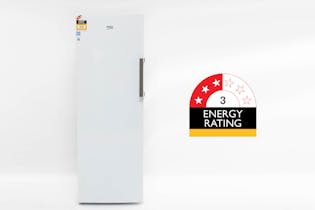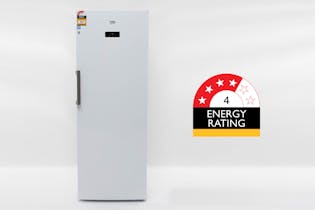Freezers
Find the best freezer for your home with our buying guide and test results for 11 current and 16 discontinued models.
Buying food in bulk can help save money, but you need a good freezer when it comes to storing your perishables long term.
Best freezers of 2025
Chest or upright, a standalone freezer is a great option that lets you store more food. Our expert recommendations help you find the right one for your home and family, looking at type, temperature performance, features and budget.
-

Best budget freezer
-

Best upright freezer
-

Best small freezer
-

Best large freezer

Get access to Consumer & see all reviews
✔ Personal support through our Consumer Rights Advice Line
✔ Premium articles and in-depth buying advice
✔ Add a Consumer magazine for even more exclusive content
Chest or vertical?
Our test results will show you the top-performing models. Plus, we’ve covered the features you should consider when buying a freezer.
We’ve also tested freezers for temperature performance, warm-up and cool-down time, and much more. Learn about how we test freezers.
There are two types of freezers: upright/vertical, which looks similar to a standard fridge, and chest, which has a hinging lid on top. Choosing your ideal type requires more than considering if it’ll keep your food cold.
Upright/vertical

Pros:
- easy to see and access food
- drawers and shelves for organising food
- most are frost-free
- small footprint.
Cons:
- not as good at keeping consistent temperature
- more expensive to buy.
Chest

Pros:
- available in larger sizes (500L+)
- better overall temperature performance
- cheaper to buy.
Cons:
- limited storage options (such as baskets)
- can be awkward reaching for food in the bottom
- usually requires manual defrosting
- takes up more space
- quicker to warm up during a power cut.
Vertical freezers interior layout
Vertical freezers are available with shelves or drawers which are easier to access. Shelves allow you to open the door and easily see what’s there. Some have extending telescopic runners, but check how easily they roll, their weight capacity and whether they have a lip at the front, sides and back to stop food falling out when you move them.
Sliding drawers may take up more potential storage space than shelves, but they make it easier to access food (check they slide smoothly). Some have opaque fronts, so you might need to label what’s in them to make finding things easier.
Does it suit your space and needs?
Measure the space in your kitchen and the doorways leading there to make sure the freezer will fit. And remember you’ll need about 5cm of space on the sides and back and 30cm on top for ventilation (check what the manufacturer recommends).
Is the door hinged on the correct side for your kitchen? If not, maybe it’s reversible? You can look up the manual online to find out.
Does it have enough shelves and drawers for your household?
What else to consider
-
Controls: Most freezer temperature controls should be regularly adjusted to account for ambient temperature changes. Upright freezers often have digital controls while chest models commonly have conventional dials, which can require a coin or screwdriver to adjust. Controls in upright freezers are often found on the front or inside of the compartment, which means you may need to move food to reach them. Chest freezer controls are often located low on the front or rear of the appliance. Check you can comfortably adjust the controls.
- Liners: Some freezers come with thin aluminium liners. Look for heavy-duty liners that won’t easily dent.
- Interior light: Lights are more common in upright models. Check the location of the light and how far it illuminates as food can block it.
-
Defrosting and draining water: Most chest freezers need regular defrosting otherwise ice can build up, stopping food from being chilled effectively. Defrosting requires you remove all the food, warm the freezer up, then drain off melted water. To make this easier, look for a model with a drain bung at the front and a spout to help minimise spills. The drain should be high enough for you to fit a container underneath.
Keeping cool
You can help your freezer manage temperature and save energy by placing it in an area with stable ambient temperatures (for example, out of the sun and away from draughts). It’s tempting to put a freezer in the garage, but large doors regularly opening and closing can result in large temperature changes occurring around it.
Buying second-hand
Before buying any second-hand appliance, check it still works. Don’t just trust the seller! For a freezer, that means inspecting it in person, if possible, and asking the seller to leave it running for at least 12 hours beforehand so you can check temperatures. If you can’t see it running before buying, reconsider the purchase.
Do your research
If the listing doesn’t state the freezer’s brand or model name, scrutinise the photos. Look for an energy rating sticker, which will state the model’s name.
Search the manufacturer’s website for information on the model, such as its manual, installation guide or product information sheet.
Check what the seller is telling you matches the manual for that model.
Check out our test results for older models (set the filter to include discontinued models), including their specifications and features. While these results are from when the model was first tested, and performance can decrease with age, we expect that a second-hand freezer less than 10 years old and kept in good condition should still perform comparably with the results.
Can’t see the model on our website? You can still check out older models’ energy efficiency on the GenLess Efficient Appliance Calculator.
Hands-on checks
Make sure it turns on.
Check the door or lid seal is intact and creates a good seal when shut. Put a torch inside it so you can see if light shines through the seal or try opening the door with your little finger (using very light pressure). If it’s easy to open, then the seals are getting old. While seals can be easily replaced, it can be a sign the appliance has been poorly maintained.
Make sure the interior is in good nick and doesn’t smell too bad. Only buy if it looks well cared for.
Look for stains, both inside and outside. These could indicate a leak.
Look for cracks in chest freezers, this can be a safety issue when the appliance is off and the ice melts.
Check the shelves and baskets aren’t cracked or buckled. These are replaceable (check the manufacturer’s website, Trade Me, your local op-shop or landfill shop), but the older a freezer is, the harder it is to find spare parts.
Listen for excessive sounds or vibrations.
Check the lights, ice and water dispensers, and temperature controls work.
Check the sides and back are in good order. Dents could potentially affect the motor or compressor.
If it’s a frost-free model, see if there’s an excessive build-up of ice. This can indicate a drainage issue.
If you can, check the temperature (we suggest using an infrared thermometer). You want it to be -15°C. Check the temperature is fairly consistent throughout the compartments.
Questions to ask the seller
Why are they selling it?
Is there anything wrong with it?
How old is it?
Has it ever been repaired?
Are they the original owner? If so, do they have the receipt?
Refrigerant gases
Refrigerant gases are what keep freezers cool. One group of gases that was once common in freezers is fluorocarbons (CFCs, HFCs and HCFCs), but these are nasty ozone-depleting substances and active greenhouse gases. Most new freezers use hydrocarbon R600a (also called isobutane), which is more environmentally friendly and energy efficient than fluorocarbons.
Most freezers have a sticker or metal plate, generally on the back, stating the model’s name and refrigerant gas. If you want a more environmentally friendly model, then look for one using R600a gas.
Safety first
The refrigerants in freezers are combustible, meaning they can catch fire. While this isn’t an issue during everyday use, it’s important to remember when you’re moving a freezer. Failing to transport one properly could mean it catches on fire when it’s turned back on because the gas hasn’t had a chance to equalise. Make sure to transport the freezer upright, as this helps keep the gas where it needs to be.
If you have to move the appliance on its side, try to keep it on an angle. Once moved, sit it upright for about 24 hours (this may vary by manufacturer, so check the manual) before turning it on – this gives the gas time to settle.
Your rights if things go wrong
Bought something and want to take it back? Here's what you need to know about your rights. Consumer members can contact our Consumer Advice Line for help. Our advisers will talk you through your rights.
Buying new
If a product you buy is faulty or not of acceptable quality, you don’t have to put up with it. The Consumer Guarantees Act has got you covered – you don’t need a warranty. Here's more about how you can get a refund, repair or replacement for a faulty product.
Buying used
What are your consumer rights when purchasing a used freezer? It depends on the seller. If you’re buying from a second-hand dealer (including those listed as “In-trade” on Trade Me) and discover it’s faulty, you're covered by the Consumer Guarantees Act. It should be of acceptable quality, fit for purpose and match the description. However, if you’re dealing with a private seller, you’re not covered by the act. Here's more info about your rights when buying second-hand goods.
People's Choice

Our People's Choice awards are granted to brands that consistently rate above average for customer satisfaction and meet out other performance criteria. Become a member and see which brands have earned a People’s Choice award.
Which brands are most reliable?

We asked thousands of Consumer members about their experience with products they've used to find out which brands are most reliable and satisfying to own. The results are available to members and Digital Pass holders.
Energy rating labels

The Energy Rating Label has a scale of stars to show how energy efficient a model is, compared to other models of the same size/capacity.
More stars = more energy efficient.
The energy consumption figure is in kilowatt-hours (kWh) and you can use this figure and the cost (tariff) from your latest power bill to calculate how much this model will cost to run. The MBIE-reported national average cost of a kWh in New Zealand is 29¢.
Lower kWh = cheaper to run.
Fridge and freezer annual energy consumption in kWh is based on standards testing and assumes the appliance is on 24 hours a day.
You should only compare star ratings of fridges or freezers with the same or similar capacities.
There are now two fridge/freezer energy rating labels, using different standards and with different ratings. For information on energy ratings and how to use them, see our Energy Rating Labels explained article.
We've tested 27 freezers.
Find the right one for you.


